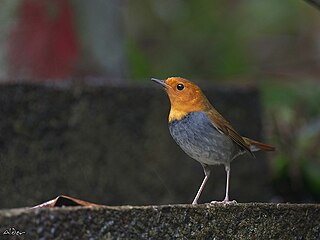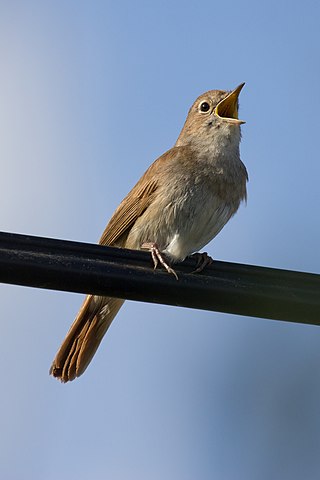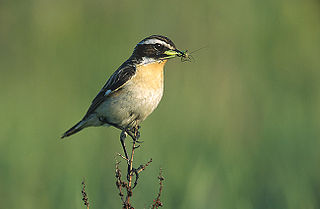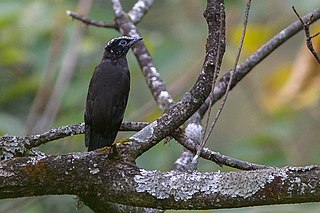
The Japanese robin is a small passerine bird in the family Muscicapidae. This species was formerly named Erithacus akahige, or Komadori. Its range extends from the south of the Kuril and Sakhalin Islands throughout Japan.

The Siberian rubythroat is a small passerine bird first described by Peter Simon Pallas in 1776. It was formerly classed as a member of the thrush family, Turdidae, but is now more generally considered to be an Old World flycatcher of the family Muscicapidae. The Siberian rubythroat and similar small European species are often called chats.

The Ryukyu robin is a bird endemic to the Ryūkyū Islands, of Japan. The Okinawa robin previously was considered a subspecies.

The thrush nightingale, also known as the sprosser, is a small passerine bird that was formerly classed as a member of the thrush family Turdidae, but is now more generally considered to be an Old World flycatcher, Muscicapidae. It, and similar small European species, are often called chats.

The common nightingale, rufous nightingale or simply nightingale, is a small passerine bird best known for its powerful and beautiful song. It was formerly classed as a member of the thrush family Turdidae, but is now more generally considered to be an Old World flycatcher, Muscicapidae. It belongs to a group of more terrestrial species, often called chats.

Chats are a group of small Old World insectivorous birds formerly classified as members of the thrush family (Turdidae), but following genetic DNA analysis, are now considered to belong to the Old World flycatcher family (Muscicapidae).

The Old World flycatchers are a large family, the Muscicapidae, of small passerine birds restricted to the Old World, with the exception of several vagrants and two species, bluethroat and northern wheatear, found also in North America. These are mainly small arboreal insectivores, many of which, as the name implies, take their prey on the wing. The family is relatively large and includes 351 species which are divided into 54 genera.

The Siberian blue robin is a small passerine bird that was formerly classified as a member of the thrush family, Turdidae, but is now more generally considered to belong to the Old World flycatcher family, Muscicapidae. It and similar small European species are often called chats. Recent research suggests that this species and some other East Asian members of Luscinia should be classified in a new genus, together with the Japanese and Ryūkyū robins. The genus name Larvivora comes from the Neo-Latin larva meaning caterpillar and -vorus meaning eating, and cyane is Latin for "dark-blue".

The Indian blue robin is a small bird found in the Indian Subcontinent. Formerly considered a thrush, it is now considered one of the Old World flycatchers in the family Muscicapidae. It was earlier also called the Indian blue chat. It is migratory, breeding in the forests along the Himalayas of Nepal, India, Myanmar and Bangladesh. They winter in the hill forests of the Western Ghats of India and in Sri Lanka.

Luscinia is a genus of smallish passerine birds, containing the nightingales and relatives. Formerly classed as members of the thrush family Turdidae, they are now considered to be Old World flycatchers (Muscicapidae) of the chat subfamily (Saxicolinae). The chats are a lineage of Old World flycatchers that has evolved convergently to thrushes.

The mountain wheatear or mountain chat is a small insectivorous passerine bird that is endemic to southwestern Africa.

The purple cochoa is a brightly coloured bird found in the temperate forests of Asia. It is a quiet and elusive bird species that has been considered to be related to the thrushes of family Turdidae or the related Muscicapidae. They are found in dark forested areas and is found in the canopy, where it often sits motionless.

The blackthroat, also known as the black-throated robin or black-throated blue robin, is a species of bird in the family Muscicapidae. It breeds in north-central China but its wintering grounds are uncertain. It has been recorded as a vagrant in northwest Thailand. Its natural habitat is bamboo thickets within coniferous forest at altitudes of 3000–3,400 metres. It is threatened by habitat loss.

The rufous-headed robin is a species of passerine bird in the family Muscicapidae. It is found in central China. Its natural habitats are temperate forests and temperate shrubland. This poorly known species is thought to be threatened by habitat loss.

Larvivora is a genus of small passerine birds belonging to the Old World flycatcher family Muscicapidae that occur in central and eastern Asia.
The Izu robin is a small passerine bird in the Old World flycatcher family Muscicapidae that is endemic to the Izu Islands of Japan.
















